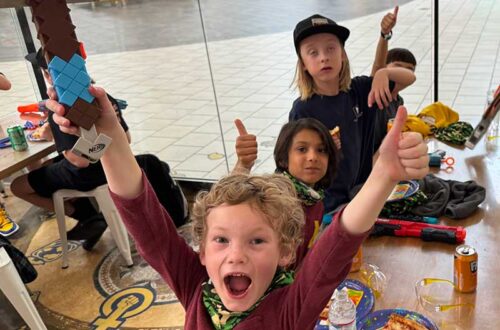
Reaching the Heart Before Reaching the Head
When you became a parent, did you say to yourself, “I’m going to love my child only under certain conditions”? This is called Conditional Love. I’m guessing this was not your goal. I’m guessing your thoughts align with wanting your child to feel loved at all times. Through all the challenges and mistakes we make, we all want to know we are loved. “I love you no matter what.” This is called Unconditional Love.
How to Love Unconditionally
The theory of parenting is the easy part. How to put it into practice is the challenging part. Let’s begin with the theory, the easy part. To set the groundwork for children to cooperate with tasks or to de-escalate from an emotional meltdown, you must first make a connection with them, and reach their hearts. Only then can you move to the next step of redirecting or correcting behavior, and reach their heads. You must reach the heart before you can reach the head. The shorthand phrase for this concept used in Positive Discipline is, “Connection before Correction.”
Brain Science Supports This Theory
When challenging emotions are engaged, the logical part of the brain shuts down. Dr. Daniel Siegel, a clinical professor of psychiatry at UCLA’s School of Medicine, has been leading the way for years in helping the world understand this fact. Science has confirmed the connection between human relations and basic biological and neurological processes.
Emotions are “housed,” if you will, in the limbic part of the brain that is close to the brain stem that ignites our fight, flight, or freeze response. These two parts of the brain often work in tandem. The question these parts of the brain ask is, “Am I loved and am I safe?” Survival. Our logical and emotional regulation skills are “housed” in the prefrontal cortex part of the brain. It asks, “What can I learn from this?” Growth.
These two parts of the brain do not operate simultaneously. Basically, when people are calm and rational, their prefrontal cortex is running the show. When emotions flood the brain, there’s a switch over to the limbic system and it is now running the show. Logic, listening, solving, emotional regulation, self-awareness, and making good choices are simply not available until the emotional storm passes. Keep in mind that the prefrontal cortex is not fully developed until our early to mid-20s. Logic and managing emotions are not something young people are known for. How could they? They don’t have a fully functional brain yet and won’t for a very long time.
During a raging emotional storm or even a mild one, the way to help get the logical brain back in charge is to reach out and connect emotionally with the young person first. Once this happens, over time, the brain begins to feel heard and safe. It shifts back to more rational thinking where conversations and solutions can be had.
Trauma-informed Practices Support This Theory
When trauma is experienced either by a single event or by small acts of abuse and neglect over time, the person’s flight, fight, or freeze response runs on overdrive, ready to defend and attack at a moment’s notice since life has proven to be unpredictable and unsafe. Situations are more likely to be misinterpreted and strong emotional responses become frequent.
The part of the brain that holds our memories is also located in the limbic system, therefore emotions and traumatic experiences become locked together in our memories. The past traumatic memory can immediately light up when emotionally triggered, and it plays out as if it is a present circumstance.
Professionals in the fields of healthcare, social services, and education receive training specific to children and adults who have experienced trauma. This training highlights the practice of following brain science which includes creating emotional safety, a calm environment, and holding off on enacting consequences or punishing time-outs during emotional moments. These practices boil down to: “Connection before Correction.”
What does “Connection before Correction” look and sound like?
Let’s go into how to put this into practice, the harder part. Why is this hard? Because when someone is being completely irrational, misinterpreting and misunderstanding the situation, saying and doing hurtful things, and repeating the same phrase over and over, (e.g. “This isn’t fair!” or “Give it to me!”), our emotions light up too and the rational part of the brain starts to shut down just like our raging child. These are our brain’s mirror neurons at play: you laugh, I laugh; you yawn, I yawn; you yell, I yell.
Secondly, have you ever tried to have important conversations with drunk people? It’s pointless until they sober up. This is because the prefrontal cortex begins to shut down under the influence of alcohol. So, when your child or teen is melting down, it’s hard to remember that they are exactly like a drunk person with no active prefrontal cortex. Parents want the loud emotions to stop and the problem fixed as soon as possible. It’s a struggle to wait for the time it takes to “sober up.”
Now you know the “why” and the “why it’s hard” part of Connection before Correction, here’s the how:
Connection Tips for Times of Directives
Get into children’s worlds before asking them to get into the adult’s world. About to ask for cooperation? Start by connecting. “Hey, hon! Whatcha doin’? Looks fun. So, a heads up. It’s almost dinner time and it’s your night to set the table.” “Looks like you dug quite a big hole in the sand with your friends. And dinosaurs in the hole too! I want to let you know we have 5 minutes until we leave. I know. It’s hard to say goodbye to friends when you’re having fun. You can invite them to join us tomorrow if you like.” Adults connect first,(e.g. “Hi, how was your weekend? I have a favor to ask.”) Young people enjoy the same courtesy
Connection Tips for Times of Big Emotion
Think safety first. You can’t have a connection if the child isn’t able to be physically safe. Take calm, firm, decisive action to create a safe space if needed. Remove objects being thrown, move child to a private place away from others, or remove yourself out of harm’s way. Say with a neutral tone, “I’m moving you to a safe space where you can be upset and not hurt others, me, or yourself.”
No old-school Time-Outs. Demanding a child sit in time-out is adding gasoline to an already ignited fire of emotions. This does nothing to activate the logical brain and instead conveys to the limbic system that you are the “enemy” and must be fought.
Create Time-Ins by utilizing a cool-off place or a calming activity. Time-Ins give space for the emotions to run their course. Go somewhere or do something that soothes the frightened, angry, confused, illogical limbic system. Be with your child keeping up a calm, neutral tone of voice. Remember this will pass. Take nothing that is said personally. It’s NOT personal; it’s raging brain talk.
Use empathetic phrases. Acknowledge and allow all feelings but not all behaviors. Speak to the limbic part of the brain looking for safety and love. State the feeling you see and support the feeling. “You’re mad you have to clean up. I understand. I get mad sometimes too. It’s okay to be mad but not okay to hit.”
Physical touch. Hug. Breathe. If your child accepts touch, reach out. “Would a hug help? I have one right here for you.” Gentle touch is very calming. Model breathing slowing; exhaling longer than inhaling calms the brain
Be present, but silent. Give physical space. If your children resist touch, empathy, or direct attention and become angrier, then pull back, but be ready to connect when they are.
Think about basic needs. Food or sleep. Low blood sugar or tiredness greatly impacts brain function. A healthy snack or rest may be what’s needed to regain equilibrium.
Follow Through with Corrections. Once the emotional storm has wound down, and the logical brain is back online, redirect, state expectations, re-state boundaries, problem-solve, make amends, address the task needing completion, etc. For young ones, the correction process can happen soon after. For older tweens and teens, hours or days later can be appropriate.
Colleen Murphy is a credentialed adult ed teacher, a Certified Positive Discipline Trainer at Positive Discipline Community Resources (www.pdcrcc.org), a preschool teacher at Soquel PENS(www.soquelpens.org), a parent coach (fromtheheadtotheheart.com), and in healthy relationships with her two grown kids.






